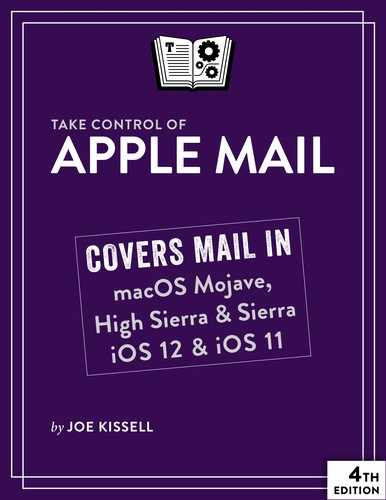Learn What’s New in Mail
The versions of Mail in Mojave, High Sierra, iOS 12, and iOS 11 contain new features and design changes since the previous edition of this book (including some that made their first appearance in Sierra and iOS 10). Skim over this chapter to see which of these changes may be important to you.
Mail Changes in Mojave
The Help > What’s New in Mail? command lists a few of the changes in Mail for Mojave:
There’s a new Emoji
 button on the toolbar of the new message window that you can use to quickly insert emoji. (I have nothing further to say about this button in the book.)
button on the toolbar of the new message window that you can use to quickly insert emoji. (I have nothing further to say about this button in the book.)If you have both a Mac running Mojave and an iPhone or iPad running iOS 12, you can use Continuity Camera to insert photos taken with your iOS device into Mail messages on your Mac in real time; see Continuity Camera.
A new Move
 button on the toolbar shows you suggested locations for moving messages based on your past behavior; see Filing. (This feature existed in High Sierra, but was more hidden; now it’s easier to find.)
button on the toolbar shows you suggested locations for moving messages based on your past behavior; see Filing. (This feature existed in High Sierra, but was more hidden; now it’s easier to find.)If you’re using Mojave’s Dark Mode, you can optionally configure Mail to show your messages with a dark background, too; see Hidden Interface Elements.
The Help window doesn’t mention the following changes, however:
The mechanism for enabling or disabling plugins is completely different—and far more complicated than it used to be; see Use Plugins in Mojave.
Mail no longer offers a Stationery feature to use predefined templates for your outgoing messages. (Although this feature is still present in the High Sierra version of Mail, I don’t cover it in this book.)
Mail now stores messages in a series of folders inside
~/Library/Mail/V6(whereas High Sierra used a folder namedV5).
In addition, Mojave incorporates changes in macOS High Sierra 10.13.5 and later to address the so-called EFAIL vulnerability; see About the EFAIL Vulnerability.
Mail Changes in High Sierra
You can be forgiven for thinking the High Sierra version of Mail looks virtually identical to the Sierra version, as the new features in Mail for High Sierra are pretty minimal:
Full-screen changes: When Mail is in full-screen mode, opening a separate message window (including when you create a new message) switches Mail into Split View so you can see your message list on the left while reading or composing a message on the right. See Full-Screen Mode.
Top Hits: Searches in Mail now show what Apple thinks are the most likely matches at the top, though I can’t recall a single time this has identified the message I was searching for. See the sidebar About Top Hits.
Text background colors: Rich text messages can now contain text with different foreground and background colors, a feature I’m pretty sure no one ever asked for. See Choose Formatting Wisely.
More efficient storage: With High Sierra’s new default file system, APFS (available only on Macs with SSD startup volumes), Apple claims that Mail requires 35% less storage space.
Mail in Sierra had a bigger list of significant changes (which I mention because I didn’t cover them in the previous edition of this book):
Tabbed windows: As in most Mac apps, windows in Mail (including the main Message Viewer window) can have multiple tabs. See Tabbed Windows.
Siri improvements: You can tell Siri things like “Read my email,” “Find emails about online privacy,” or “Send an email to Joe about the Apple Mail book.” (I don’t cover the use of Siri in this book.)
Message filters: You can selectively show in your message list only those messages that meet certain criteria. See Message Filters.
Rearranged preferences: The Mail > Preferences > Accounts pane was reorganized and simplified.
Revised From address logic: Mail tries to be smarter about choosing which of several accounts an outgoing message should be sent from—but doesn’t always succeed. See Addressing.
Mail Changes in iOS 12
I searched high and low for indications of changes to Mail in iOS 12, and I came up with only two trivial things (which aren’t even specific to Mail):
If someone emails you an augmented reality (AR) file in USDZ format, you can tap it in Mail to view its contents.
When using Markup in Mail (see Add an Inline Drawing), you can now choose from any of 120 colors, not just six.
Mail Changes in iOS 11
The iOS 11 version of Mail contained several important new features:
Inline drawing: With your fingertip or (on iPads that support it) an Apple Pencil, you can create drawings right inside Mail messages. See Add an Inline Drawing.
Settings changes: In addition to the settings changes introduced in iOS 10, you now go to an entirely different place to set up a new account. See Change Account Settings.
Collapse read messages: A new Mail setting enables you to shrink down the display of already-read messages in a thread, making it easier for you to find and focus on the newest ones. Again, see Change Account Settings.
Drag and drop support on iPad: If you have a relatively recent iPad, you can use drag and drop both within Mail and between applications (for example, to drag text or an image from another app into Mail to use as an attachment). And, if you drag a folder in from the Files app, Mail zips it for you automatically. See Use Drag and Drop.
